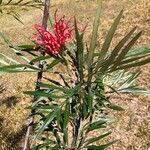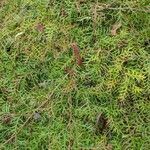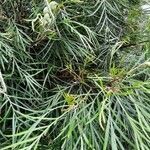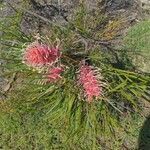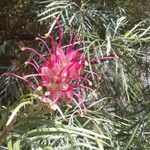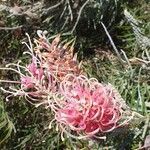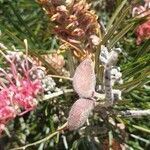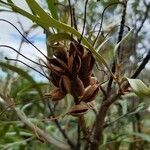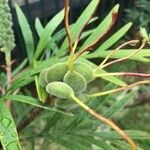Bushy to spindly erect shrub or slender tree, 2-10 m high, or rarely a prostrate to sprawling shrub. Leaves 8-30 cm long, pinnatipartite (rarely the odd leaf entire); lobes 4-12, narrowly elliptic to linear, 5-18 cm long, 5-15 mm wide, not pungent; margins shortly recurved or revolute; lower surface usually mostly exposed, subsericeous to subvillous. Conflorescence simple or few-branched; unit conflorescence erect, ±cylindrical, irregular to subsynchronous; floral rachis 50-120 (-200?) mm long. Flower colour: perianth creamy white or bright scarlet to crimson, rarely pink to apricot with a yellow limb; style usually matching perianth in colour, rarely much paler. Perianth open-tomentose to shortly pilose outside with both biramous and simple erect hairs. Pistil 32-50 mm long; style sometimes with biramous hairs for up to 4 mm above ovary, otherwise glabrous, lacking a dorsal hump immediately below style-end. Follicle 15-25 mm long, tomentose with biramous hairs mostly replaced by erect simple glandular hairs as fruit matures.
A shrub or small tree. It grows 2.4-9 m high. It can spread to 2 m wide. The small branches and flowers have a soft brown covering over them. Some coastal forms almost lie along the ground. The leaf stalk is 3-5 cm long. The leaf blade is 7-20 cm long and deeply divided. There are 3-11 segments and these are 50-100 mm long by 4-7 mm wide. The edges curve back. They are brown and silky underneath. The flowering racemes are at the ends and 5-13 cm long. They occur either singly or as 2 or 3 in a group. The flowers are red. The fruit is oval but not straight. It is 1.5-2 cm long and hairy. The seeds have narrow wings.
A tall, erect, open shrub up to 8 m tall, but with prostrate, creeping and bushy variants. Leaves up to 250 mm long, green above, with grey, silky hairs below, deeply incised into 5-11 lobes. Flowerhead terminal or axillary at the tips of branches, 100 mm long, a cylindrical raceme. Perianth pinkish red, hairy on outer surfaces. Style 40 mm long, red, with a yellow, disc-like pollen presenter. Flowers : All year.
